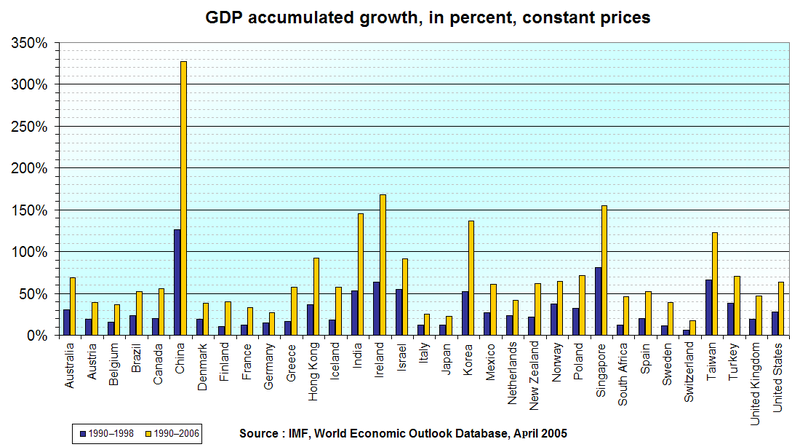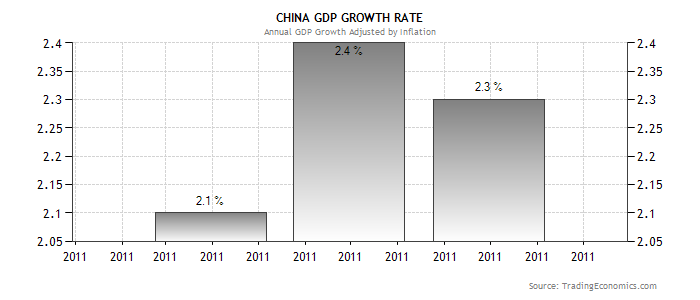Introduction
The economy is a complex intertwined system consisting of many parts that work collectively to produce output. Principles of economics are wide and diverse. They help in explaining the complexities associated with the economic system, besides providing crucial indicators for economic direction and wellbeing. Though these principles change with economic dynamism, their basic meanings are static and understanding them is crucial to understanding economics phenomena.
Taking the above into account, this discussion will briefly highlight on some of the major economic concepts, to aid in increased understanding of the discipline. These concepts include economic growth, unemployment, hyperinflation, deficit vs debt, exchange rate and great depression and great recession.
Economic growth
Economic growth refers to the increasing of an economy’s capability to sufficiently meet a particular population’s needs in terms of goods and services (Wessels 98). Economists normally measure economic growth by determining the increase in productivity as reflected in the Gross Domestic Product (GDP) normally, economic growth leads to a drop in costs of economic indicators such as labor, capital and materials.
Additionally, increased demand for goods and services and growth in the average income of the population indicates economic growth. The graph below shows how different countries compare in GDP growth rates.

Source: International Monetary Fund
In the recent past, Asia and Africa have been experiencing phenomenal economic growth rates. Besides the Asian tiger economies, China has posted consistent high growth rates effectively making it the biggest economy in the world behind only the US. Though the Asian Tigers are doing well, China is doing better in terms of economic growth. For instance, the GDP of China rose by 2.3% in the third quarter of 2011 on a seasonally adjusted quarter on quarter basis as the graph below illustrates.

China’s GDP expansion in 2011. Source Tradingeconomics.com
Due to the rapid growth, estimates put China’s economic worth at slightly over $10 trillion compared with that of Hong Kong at slightly over $2 trillion. One of the most important economic growth indicators is employment. The employment rate shows the number of eligible people in the labour force being absorbed into the job market.
Unemployment
Unemployment or joblessness on the other hand refers to a situation where people are without jobs after actively engaging in job search within a specified time (McConnell et al 235). Unemployment rate measures unemployment through division of the number of unemployed people by the entire labour force.
High unemployment rates have for a long time been synonymous with developing countries. However, the global financial crisis has led to loss of jobs in developed nations raising the unemployment rates to unprecedented highs. The Table below illustrates unemployment rates of selected countries.
Unemployment rates for selected countries Source: Division of International Labor Comparisons
The US for instance was one of the most affected countries in the crisis with unemployment rate surpassing 9% for several months due to layoffs resulting from closed down businesses. As of November 2011, the US unemployment rate stands at 8.6%. The US however does better compared to other countries such as Spain and Greece with unemployment rates of 21.5% and 18.4% respectively.
The two European nations’ unemployment rates have especially risen due to near total collapse of their economic systems whose origin is the global financial crisis and economic mismanagement. Another important economic indicator besides unemployment is inflation (McConnell et al. 138).
Hyperinflation
Economists use inflation rates to determine the amount of money in circulation as well as the cost of living. Hyperinflation refers to inflation that is out of control (Baumol 146). Normally, the currency involved loses its real value at an accelerating rate that monetary institutions like central banks can hardly control. According to the International Accounting Standards Board, cumulative inflation that stretches over three years and approaches or reaches 100% becomes hyperinflation.
In the above scenario, every cycle of inflation creates the necessity for printing of more money to an extent that money supply is not regulated as was the case in Zimbabwe. In Zimbabwe’s case, local currency, Zimbabwean Dollar devaluation triggered the hyperinflation. The devaluation resulted from falling exports hence little or no foreign currency reserves.
The government then printed money with face value of up to 100 trillion-dollar notes to pay for its bills leading to hyperinflation of over 11,000%. Government spending is critical in economic growth and development. Every government has a financial year where it lays its estimates on revenues and expenditure.
Receipts are the collections the government makes while outlays are the expenditure. A negative difference between the two is the deficit. A deficit represents a shortage in revenue when outlays are more than the receipts. In that case, the government borrows money through sale of T-bills and notes, effectively creating debt. Given its nature, it is safe to refer to debt as accumulated deficits.
It is important that national debt does not pass a certain percentage of the GDP. However, countries like the US have public debt amounting to almost 97% of its GDP, a precarious situation that can easily cause economic collapse. The US however is better off compared to other countries such as Japan with a national debt, 228% of GDP and Italy with a national debt, 115% of GDP (Baumol 209).
Great Depression and Great Recession
In the market economy, that is dominant in the world today, economic cycles have become a norm. Economic shocks such as lack of credit or rise in oil prices lead to slump or growth periods of the economies hence cycles such as the Great Depression and the Great Recession. The stock market crashes of 1929-1930 and 2008-2009 led to a slump in the economic activities in many nations. The great depression was more severe compared to the 2008 great recession.
The great depression affected trade and capital flows as well as commodity prices. The great recession on its part affected credit flow as well as collapse of the housing and financial markets. The US which is still making a painfully slow recovery was the most affected in the great recession with over 14 million Americans losing their jobs and major financial institutions collapsing. In other countries like Japan, industries such as manufacturing experienced a slump, whose effect is still felt today (Baumol 397).
Exchange Rate
All economic activities use medium of exchange i.e. money whose design depends on a particular territory’s currency. International transactions between nations take place through currency exchange as determined by the exchange rate. The exchange rate therefore is the rate at which one currency will exchange for another (McConnell et al. 49). In essence it’s the value of one country’s currency in terms of another.
The most dominant currency in the world is the Dollar. Many transactions take place using the dollar and numerous central banks have the dollar as their reserve currency. Many countries as a result have little choice but to peg their national currencies to the dollar. Besides the Dollar, other major currencies include the Euro, the Pound and the Japanese Yen. Many currencies appreciation or depreciation takes place against these currencies.
The Euro for instance has appreciated against the Dollar and currently (05th December 11:52 am GMT+3) trades at 1 Euro = 1.3462 U.S. dollars. The Chinese currency is weaker than the dollar and currently (05th December 11:52 am GMT+3) it trades at 1 U.S. dollar = 6.36290174 Chinese yuan, though the US believes depreciation of the Yuan is through manipulation.
Conclusion
Despite the above principles being important, they hardly form the bulk of economic concepts needed for full comprehension of economics. Nevertheless, the information contained on the discussion is crucial in understanding the basic economic variations that people encounter every day.
Perhaps to underscore their importance, the above concepts are the most discussed currently, thanks to the Great Recession and the looming European recession. While understanding concepts such as economic growth, unemployment, hyperinflation, exchange rate and cycles such as the Great Depression and Great Recession is important, understanding how they work together to for the overall wellbeing of the economy is crucial as well.
Works Cited
Baumol, William. Economics: Principles and Policy. London: Sage Publications, 2011. Print.
McConnell, Campbell et al. Economics. New York: Cengage Learning, 2011. Print.
Wessels, Walter. Economics. New York: Routledge, 2006. Print.